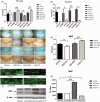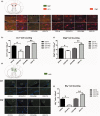Thyroid hormone alleviates demyelination induced by cuprizone through its role in remyelination during the remission period
- PMID: 25577802
- PMCID: PMC4935357
- DOI: 10.1177/1535370214565975
Thyroid hormone alleviates demyelination induced by cuprizone through its role in remyelination during the remission period
Abstract
Multiple sclerosis (MS) is a disease induced by demyelination in the central nervous system, and the remission period of MS is crucial for remyelination. In addition, abnormal levels of thyroid hormone (TH) have been identified in MS. However, in the clinic, insufficient attention has been paid to the role of TH in the remission period. Indeed, TH not only functions in the development of the brain but also affects myelination. Therefore, it is necessary to observe the effect of TH on remyelination during this period. A model of demyelination induced by cuprizone (CPZ) was used to observe the function of TH in remyelination during the remission period of MS. Through weighing and behavioral tests, we found that TH improved the physical symptoms of mice impaired by CPZ. Supplementation of TH led to the repair of myelin as detected by immunohistochemistry and western blot. In addition, a sufficient TH supply resulted in an increase in myelinated axons without affecting myelin thickness and g ratio in the corpus callosum, as detected by electron microscopy. Double immunostaining with myelin basic protein and neurofilament 200 (NF200) showed that the CPZ-induced impairment of axons was alleviated by TH. Conversely, insufficient TH induced by 6-propyl-2-thiouracil resulted in the enlargement of mitochondria. Furthermore, we found that an adequate supply of TH promoted the proliferation and differentiation of oligodendrocyte lineage cells by immunofluorescence, which was beneficial to remyelination. Further, we found that TH reduced the number of astrocytes without affecting microglia. Conclusively, it was shown that TH alleviated demyelination induced by CPZ by promoting the development of oligodendrocyte lineage cells and remyelination. The critical time for remyelination is the remission period of MS. TH plays a significant role in alleviating demyelination during the remission period in the clinical treatment of MS.
Keywords: Thyroid hormone; corpus callosum; multiple sclerosis; myelin; oligodendrocyte.
© 2015 by the Society for Experimental Biology and Medicine.
Figures






Similar articles
-
Cuprizone-induced demyelination in the rat cerebral cortex and thyroid hormone effects on cortical remyelination.Exp Neurol. 2012 May;235(1):357-67. doi: 10.1016/j.expneurol.2012.02.018. Epub 2012 Mar 7. Exp Neurol. 2012. PMID: 22421533
-
rHIgM22 enhances remyelination in the brain of the cuprizone mouse model of demyelination.Neurobiol Dis. 2017 Sep;105:142-155. doi: 10.1016/j.nbd.2017.05.015. Epub 2017 May 30. Neurobiol Dis. 2017. PMID: 28576706
-
Single intracerebroventricular TNFR2 agonist injection impacts remyelination in the cuprizone model.J Mol Med (Berl). 2025 Jul;103(7):795-807. doi: 10.1007/s00109-025-02549-6. Epub 2025 May 10. J Mol Med (Berl). 2025. PMID: 40347238 Free PMC article.
-
The roles of microglia and astrocytes in phagocytosis and myelination: Insights from the cuprizone model of multiple sclerosis.Glia. 2022 Jul;70(7):1215-1250. doi: 10.1002/glia.24148. Epub 2022 Feb 2. Glia. 2022. PMID: 35107839 Free PMC article. Review.
-
De- and remyelination in the CNS white and grey matter induced by cuprizone: the old, the new, and the unexpected.Histol Histopathol. 2011 Dec;26(12):1585-97. doi: 10.14670/HH-26.1585. Histol Histopathol. 2011. PMID: 21972097 Review.
Cited by
-
Thyroid Hormone and Neural Stem Cells: Repair Potential Following Brain and Spinal Cord Injury.Front Neurosci. 2020 Aug 26;14:875. doi: 10.3389/fnins.2020.00875. eCollection 2020. Front Neurosci. 2020. PMID: 32982671 Free PMC article. Review.
-
Quetiapine has an additive effect to triiodothyronine in inducing differentiation of oligodendrocyte precursor cells through induction of cholesterol biosynthesis.PLoS One. 2019 Sep 6;14(9):e0221747. doi: 10.1371/journal.pone.0221747. eCollection 2019. PLoS One. 2019. PMID: 31490950 Free PMC article.
-
Sobetirome prodrug esters with enhanced blood-brain barrier permeability.Bioorg Med Chem. 2016 Nov 15;24(22):5842-5854. doi: 10.1016/j.bmc.2016.09.038. Epub 2016 Sep 16. Bioorg Med Chem. 2016. PMID: 27707627 Free PMC article.
-
Nuclear hormone receptors in demyelinating diseases.J Neuroendocrinol. 2022 Jul;34(7):e13171. doi: 10.1111/jne.13171. Epub 2022 Jun 22. J Neuroendocrinol. 2022. PMID: 35734821 Free PMC article. Review.
-
Myelin repair stimulated by CNS-selective thyroid hormone action.JCI Insight. 2019 Apr 18;4(8):e126329. doi: 10.1172/jci.insight.126329. eCollection 2019 Apr 18. JCI Insight. 2019. PMID: 30996143 Free PMC article.
References
-
- Trapp BD, Peterson J, Ransohoff RM, Rudick R, Mork S, Bo L. Axonal transection in the lesions of multiple sclerosis. N Engl J Med 1998; 338: 278–85. - PubMed
-
- Waxman SG. Demyelinating diseases—new pathological insights, new therapeutic targets. N Engl J Med 1998; 338: 323–5. - PubMed
-
- Scolding N, Franklin R. Axon loss in multiple sclerosis. Lancet 1998; 352: 340–1. - PubMed
-
- Wingerchuk DM, Weinshenker BG. Multiple sclerosis: epidemiology, genetics, classification, natural history, and clinical outcome measures. Neuroimaging Clin N Am 2000; 10: 611–24, vii. - PubMed
-
- Kister I, Chamot E, Salter A, Cutter G, Bacon T, Kalina J, Herbert J. Natural history of MS symptoms: perceived disease impact across disease span in nine neurologic domains among enrollees in North American Research Committee on Multiple Sclerosis (NARCOMS) Registry. Neurology 2012; 78: 19–27.
Publication types
MeSH terms
Substances
LinkOut - more resources
Full Text Sources
Other Literature Sources

